Integrative Groundwater Studies in a Small-Scale Urban Area: Case Study from the Municipality of Penafiel (NW Portugal)
Abstract
:1. Introduction
“Water is the blood of a city; of your good or poor quality depends on much of the health status of a population”(Bourbon e Noronha, 1885)
2. Materials and Methods
3. Penafiel Urban Area: Setting and Historical Background
3.1. General Setting and Hydroclimatology
3.2. Urban Hydro-Historical Milestones
3.3. Urban Hydraulics and Penafiel’s Water Supply
4. Results and Discussion
5. Urban Hydrogeological Site Conceptual Model
6. Conclusions
Author Contributions
Funding
Acknowledgments
Conflicts of Interest
References
- Tricart, J. Géomorphologie et Eaux Souterraines. Available online: https://iahs.info/uploads/dms/05603.pdf (accessed on 16 December 2019).
- Biswas, A.K. Sustainable water development for developing countries. Water Res. Develop. 1988, 4, 233–242. [Google Scholar] [CrossRef]
- Novotny, V. Sustainable urban water management. In Water and Urban Development Paradigms: Towards an Integration of Engineering, Design and Management Approaches, 1st ed.; Feyen, J., Shannon, K., Neville, M., Eds.; CRC Press, Taylor & Francis Group: Boca Raton, FL, USA, 2008. [Google Scholar]
- Vrba, J.; Th. Verhagen, B. Groundwater emergency situations: A methodological guide. In IHP-VII Series on Groundwater No. 3; International Hydrological Programme, Division of Water Sciences, UNESCO: Paris, France, 2011. [Google Scholar]
- Van Leeuwen, K.; Frijns, J.; van Wezel, A.; van de Ven, F.H.M. Cities blueprints: 24 indicators to assess the sustainability of the urban water cycle. Water Res. Manag. 2012, 26, 2177–2197. [Google Scholar] [CrossRef]
- Martínez-Navarrete, C.; Jiménez-Madrid, A.; Castaño, S.; Luquem, J.A.; Carrasco, F. Integration of groundwater protection for human consumption in land use planning. Eur. Geol. J. 2013, 38, 53–58. [Google Scholar]
- Petitta, M. New challenges for hydrogeologists. Eur. Geol. J. 2013, 35, 6–8. [Google Scholar]
- Foster, S.; MacDonald, A. The ‘water security’ dialogue: Why it needs to be better informed about groundwater. Hydrogeol. J. 2014, 22, 1489–1492. [Google Scholar] [CrossRef]
- McDonald, R.; Weber, K.; Padowski, J.; Floerke, M.; Schneider, C.; Green, P.; Gleeson, T.; Eckman, S.; Lehner, B.; Balk, D.; et al. Water on an urban planet: Urbanization and the reach of urban water infrastructure. Glob. Environ. Chang. 2014, 27, 96–105. [Google Scholar] [CrossRef] [Green Version]
- Kaushal, S.S.; McDowell, W.H.; Wollheim, W.M.; Johnson, T.A.N.; Mayer, P.M.; Belt, K.T.; Pennino, M.J. Urban evolution: The role of water. Water 2015, 7, 4063–4087. [Google Scholar] [CrossRef]
- Koop, S.H.A.; van Leeuwen, C.J. Assessment of the sustainability of water resources management: A critical review of the city blueprint approach. Water Res. Manag. 2015, 29, 5649–5670. [Google Scholar] [CrossRef] [Green Version]
- Chaminé, H.I.; Gómez-Gesteira, M. Sustainable resource management: Water practice issues. Sustain. Water Resour. Manag. 2019, 5, 3–9. [Google Scholar] [CrossRef] [Green Version]
- Gundaa, T.; Hess, D.; Hornberger, G.M.; Worland, S. Water security in practice: The quantity-quality-society nexus. Water Securit. 2019, 6, 100022. [Google Scholar] [CrossRef]
- UN—United Nations. Transforming Our World: The 2030 Agenda for Sustainable Development; United Nations: New York, NY, USA, 2015. [Google Scholar]
- UN—United Nations. Tracking Progress towards Inclusive, Safe, Resilient and Sustainable Cities and Human Settlements; SDG 11 Synthesis Report; United Nations High Level Political Forum: Nairobi, Kenya, 2018. [Google Scholar] [CrossRef]
- UN—United Nations. Water and Sanitation Interlinkages across the 2030 Agenda for Sustainable Development; United Nations: Geneva, Switzerland, 2016. [Google Scholar]
- Guppy, L.; Uyttendaele, P.; Villholth, K.G.; Smakhtin, V. Groundwater and Sustainable Development Goals: Analysis of Interlinkages; UNU-INWEH Report Series, Issue 04; United Nations, University Institute for Water, Environment and Health: Hamilton, ON, Canada, 2018. [Google Scholar]
- Hoekstra, A.Y.; Buurman, J.; van Ginkel, K.C.H. Urban water security: A review. Environ. Res. Lett. 2018, 13, 053002. [Google Scholar] [CrossRef] [Green Version]
- Tortajada, C.; Biswas, A.K. Water as a human right. Int. J. Water Res. Develop. 2017, 33, 509–511. [Google Scholar] [CrossRef] [Green Version]
- Guimarães, L.; Guilhermino, L.; Afonso, M.J.; Marques, J.M.; Chaminé, H.I. Assessment of urban groundwater: Towards integrated hydrogeological and effects-based monitoring. Sustain. Water Resour. Manag. 2019, 5, 217–233. [Google Scholar] [CrossRef]
- Garrick, D.; De Stefano, L.; Yu, W.; Jorgensen, I.; O’Donnell, E.; Turley, L.; Aguilar-Barajas, I.; Dai, X.; Souza-Leão, R.; Punjabi, B.; et al. Rural water for thirsty cities: A systematic review of water reallocation from rural to urban regions. Environ. Res. Lett. 2019, 14, 043003. [Google Scholar] [CrossRef]
- Margat, J.; van der Gun, J. Groundwater around the World: A Geographic Synopsis; CRC Press, Taylor & Francis Group: Boca Raton, FL, USA, 2013. [Google Scholar]
- Chaminé, H.I. Water resources meet sustainability: New trends in environmental hydrogeology and groundwater engineering. Environ. Earth Sci. 2015, 73, 2513–2520. [Google Scholar] [CrossRef]
- Kresik, N.; Mikszewski, A. Hydrogeological Conceptual Site Models: Data Analysis and Visualization; CRC Press, Taylor and Francis Group: Boca Raton, FL, USA, 2013. [Google Scholar]
- Chaminé, H.I.; Carvalho, J.M.; Teixeira, J.; Freitas, L. Role of hydrogeological mapping in groundwater practice: Back to basics. Eur. Geol. J. 2015, 40, 34–42. [Google Scholar]
- Chaminé, H.I.; Teixeira, J.; Freitas, L.; Pires, A.; Silva, R.S.; Pinho, T.; Monteiro, R.; Costa, A.L.; Abreu, T.; Trigo, J.F.; et al. From engineering geosciences mapping towards sustainable urban planning. Eur. Geol. J. 2016, 41, 16–25. [Google Scholar]
- Enemark, T.; Peeters, L.J.M.; Mallants, D.; Batelaan, O. Hydrogeological conceptual model building and testing: A review. J. Hydrol. 2018, 569, 310–329. [Google Scholar] [CrossRef]
- Sui, D.Z. GIS-based urban modelling: Practices, problems and prospects. Int. J. Geogr. Inf. Sci. 1998, 12, 651–671. [Google Scholar] [CrossRef]
- Legrand, H.E.; Rosen, L. Systematic makings of early stage hydrogeologic conceptual models. Ground Water 2000, 38, 887–893. [Google Scholar] [CrossRef]
- Gogu, R.C.; Carabin, G.; Hallet, V.; Peters, V.; Dassargues, A. GIS-based hydrogeological databases and groundwater modelling. Hydrogeol. J. 2001, 9, 555–569. [Google Scholar] [CrossRef]
- Griffiths, J.S.; Stokes, M. Engineering geomorphological input to ground models: An approach based on earth systems. Q. J. Eng. Geol. Hydrogeol. 2008, 41, 73–91. [Google Scholar] [CrossRef]
- Ballukraya, P.N.; Kalimuthu, R. Quantitative hydrogeological and geomorphological analyses for groundwater potential assessment in hard rock terrains. Current Sci. 2010, 98, 253–259. [Google Scholar]
- Zaporozec, A. Groundwater contamination inventory: A methodological guide with a model legend for groundwater contamination inventory and risk maps. In IHP-VII Series on Groundwater No. 2; International Hydrological Programme, Division of Water Sciences, UNESCO: Paris, France, 2004. [Google Scholar]
- Freitas, L.; Afonso, M.J.; Pereira, A.J.S.C.; Delerue-Matos, C.; Chaminé, H.I. Assessment of sustainability of groundwater in urban areas (Porto, NW Portugal): A GIS mapping approach to evaluate vulnerability, infiltration and recharge. Environ. Earth Sci. 2019, 78, 140. [Google Scholar] [CrossRef]
- Freitas, L.; Chaminé, H.I.; Pereira, A.J.S.C. Coupling groundwater GIS mapping and geovisualisation techniques in urban hydrogeomorphology: Focus on methodology. SN Appl. Sci. 2019, 1, 490. [Google Scholar] [CrossRef] [Green Version]
- Gogu, R.C.; Dassagues, A. Current trends and future challenges in groundwater vulnerability assessment using overlay and index methods. Environ. Geol. 2000, 39, 549–559. [Google Scholar] [CrossRef]
- Aller, L.; Bennet, T.; Lehr, J.H.; Petty, R.J. DRASTIC: A Standardized System for Evaluating Groundwater Pollution Potential Using Hydrologic Settings; US EPA Report, 600/2-87/035; Robert, S. Kerr Environmental Research Laboratory: Ada, OK, USA, 1987. [Google Scholar]
- Foster, S.D.; Hirata, R.; Gomes, D.; D’Elia, M.; Paris, M. Groundwater Quality Protection: A Guide for Water Utilities, Municipal Authorities, and Environment Agencies; The World Bank: Washington, DC, USA, 2002. [Google Scholar]
- Denny, S.C.; Allen, D.N.; Journeay, J.M. DRASTIC-Fm: A modified vulnerability mapping method for structurally controlled aquifers in the southern Gulf Islands, British Columbia, Canada. Hydrogeol. J. 2007, 15, 483–493. [Google Scholar] [CrossRef]
- Civita, M.V. The combined approach when assessing and mapping groundwater vulnerability to contamination. J. Water Resour. Prot. 2010, 2, 14–28. [Google Scholar] [CrossRef] [Green Version]
- Ribeiro, L.; Pindo, J.C.; Dominguez-Granda, L. Assessment of groundwater vulnerability in the Daule aquifer, Ecuador, using the susceptibility index method. Sci. Total Environ. 2017, 574, 1674–1683. [Google Scholar] [CrossRef]
- Jaiswal, R.K.; Mukherjee, S.; Krishnamurthy, J.; Saxena, R. Role of remote sensing and GIS techniques for generation of groundwater prospect zones towards rural development: An approach. Int. J. Remote Sens. 2003, 24, 993–1008. [Google Scholar] [CrossRef]
- Yeh, H.-F.; Lee, C.-H.; Hsu, K.-C.; Chang, P.-H. GIS for the assessment of the groundwater recharge potential zone. Environ. Geol. 2009, 58, 185–195. [Google Scholar] [CrossRef]
- Jha, M.K.; Chowdhury, A.; Chowdary, V.; Peiffer, S. Groundwater management and development by integrated remote sensing and geographic information systems: Prospects and constraints. Water Resour. Manag. 2007, 21, 427–467. [Google Scholar] [CrossRef]
- Teixeira, J.; Chaminé, H.I.; Carvalho, J.M.; Pérez-Alberti, A.; Rocha, F. Hydrogeomorphological mapping as a tool in groundwater exploration. J. Maps 2013, 9, 263–273. [Google Scholar] [CrossRef]
- Teixeira, J.; Chaminé, H.I.; Espinha Marques, J.; Carvalho, J.M.; Pereira, A.J.; Carvalho, M.R.; Fonseca, P.E.; Pérez-Alberti, A.; Rocha, F. A comprehensive analysis of groundwater resources using GIS and multicriteria tools (Caldas da Cavaca, Central Portugal): Environmental issues. Environ. Earth Sci. 2015, 73, 2699–2715. [Google Scholar] [CrossRef]
- Afonso, M.J.; Freitas, L.; Chaminé, H.I. Groundwater recharge in urban areas (Porto, NW Portugal): The role of GIS hydrogeology mapping. Sustain. Water Resour. Manag. 2019, 5, 203–216. [Google Scholar] [CrossRef]
- Kim, G.-B.; Ahn, J.-S.; Marui, A. Analytic hierarchy models for regional groundwater monitoring well allocation in Southeast Asian countries and South Korea. Environ. Earth Sci. 2009, 59, 325–338. [Google Scholar] [CrossRef]
- Saaty, T.L. Decision Making for Leaders: The Analytic Hierarchy Process for Decisions in a Complex World, 3rd ed.; RWS Publications: Pittsburgh, PA, USA, 2012. [Google Scholar]
- Brunelli, M. Introduction to the Analytic Hierarchy Process. In SpringerBriefs in Operations Research; Springer: Berlin, Germany, 2015. [Google Scholar]
- Mu, E.; Pereyra-Rojas, M. Understanding the Analytic Hierarchy Process; Springer: Cham, Switzerland, 2017. [Google Scholar]
- Afonso, M.J.; Chaminé, H.I.; Carvalho, J.M.; Marques, J.M.; Gomes, A.; Araújo, M.A.; Fonseca, P.E.; Teixeira, J.; Marques da Silva, M.; Rocha, F. Urban Groundwater Resources: A Case Study of Porto City in Northwest Portugal. In Urban Groundwater: Meeting the Challenge; Howard, K.W.F., Ed.; International Association of Hydrogeologists Selected Papers SP8; CRC Press, Taylor & Francis Group: London, UK, 2007; pp. 271–287. [Google Scholar]
- INE—Instituto Nacional de Estatística. Informação estatística sobre a população portuguesa: Concelho de Penafiel. 2011. Available online: https://www.ine.pt/ (accessed on 5 February 2019).
- Medeiros, A.; Pereira, E.; Moreira, A. Carta Geológica de Portugal, escala 1/50.000. Folha 9-D (Penafiel); Serviços Geológicos de Portugal: Lisboa, Portugal, 1981. [Google Scholar]
- McKnight, T.L.; Hess, D. Climate Zones and Types: The Köppen System; Prentice Hall: Upper Saddle River, NJ, USA, 2000. [Google Scholar]
- Peel, M.C.; Finlayson, B.L.; McMahon, T.A. Updated world map of the Köppen-Geiger climate classification. Hydrol. Earth Syst. Sci. 2007, 11, 1633–1644. [Google Scholar] [CrossRef] [Green Version]
- Silva, A.F. Problems of agency and technological issues in the municipalisation of water supply systems, Portugal (1850–1930). In Proceedings of the Seventh International Conference on Urban History: European City in Comparative Perspective, Athens, Greece, 27–30 October 2004; pp. 1–35. [Google Scholar]
- Pires de Almeida, M.A. The Portuguese Cholera morbus epidemic of 1853-56 as seen by the press. Not. Record. Royal Soc. 2012, 66, 41–53. [Google Scholar] [CrossRef]
- Chaminé, H.I.; Afonso, M.J.; Freitas, L. From historical hydrogeological inventory through GIS mapping to problem solving in urban groundwater systems. Eur. Geol. J. 2014, 38, 33–39. [Google Scholar]
- Freitas, L.; Afonso, M.J.; Devy-Vareta, N.; Marques, J.M.; Gomes, A.; Chaminé, H.I. Coupling hydrotoponymy and GIS cartography: A case study of hydro-historical issues in urban groundwater systems, Porto, NW Portugal. Geogr. Res. 2014, 52, 182–197. [Google Scholar] [CrossRef]
- Afonso, M.J.; Freitas, L.; Pereira, A.J.S.C.; Neves, L.J.P.F.; Guimarães, L.; Guilhermino, L.; Mayer, B.; Rocha, F.; Marques, J.M.; Chaminé, H.I. Environmental groundwater vulnerability assessment in urban water mines (Porto, NW Portugal). Water 2016, 8, 499. [Google Scholar] [CrossRef] [Green Version]
- Afonso, M.J.; Freitas, L.; Devy-Vareta, N.; Teixeira, J.; Fontes, G.; Chaminé, H.I. Cartografia subterrânea dos antigos mananciais de Paranhos e Salgueiros para o abastecimento de água à cidade do Porto (NW de Portugal): Contexto e marcos históricos. In Xeomorfoloxía e Paisaxes Xeográficas: Catro décadas de investigación e Ensino; Blanco Chao, R., Castillo-Rodríguez, F., Costa-Casáis, M., García, J.H., Valcárcel-Díaz, M., Eds.; Homenaxe a Augusto Pérez Alberti. Série Homenaxes, Universidade de Santiago de Compostela Publicacións: Santiago de Compostela, Spain, 2018; pp. 261–292. [Google Scholar]
- Landmann, G. Historical, Military, and Picturesque Observations on Portugal, Illustrated by Seventy-Five Coloured Plates, including Authentic Plans of the Sieges and Battles Fought in the Peninsula during the Later War; Printed by T. Cadell and W. Davies; W. Bulmer & Co.: London, UK, 1821; Volume 2, pp. 258–259. [Google Scholar]
- MI-DGS—Ministério do Interior da Direcção Geral de Saúde. Notícia dos inquéritos de higiene rural e sobre águas e esgotos. Volume II—Águas e esgotos (questionário e respostas circular n.º 1:087 da Direcção Geral de Saúde, de 7 de Dezembro de 1932, informações complementares, pareceres do Conselho Superior de Higiene e da Junta Sanitária de Águas); Ministério do Interior da Direcção Geral de Saúde, Imprensa Nacional de Lisboa: Lisboa, Portugal, 1935; p. 671. [Google Scholar]
- MOPC—Ministério das Obras Públicas e Comunicações. Inquérito sôbre o abastecimento de águas e saneamento das sedes de concelho do País, realizado pela comissão de engenheiros nomeada pelo Ministro das Obras Públicas e Comunicações por portarias de 12 de Janeiro e 23 de Maio de 1934. Distrito do Porto; In Águas e saneamento aos concelhos—praias e termas; Mercados e matadouros; Ministério das Obras Públicas e Comunicações: Lisboa, Portugal, 1935; pp. 221–236. [Google Scholar]
- Vieira de Campos, R.G. Projecto de pesquizas e captação de água, no logar de Parafita, destinada ao abastecimento da cidade de Penafiel (distrito do Porto, concelho de Penafiel, lugar das duas egrejas). Peças escritas e desenhadas; Ministério das Obras Públicas e Comunicações, Direcção Geral dos Serviços Hidráulicos e Eléctricos, 1ª Direcção de Hidráulica- Douro (Águas e Saneamento): Lisboa, Portugal, 1937; p. 23, (unpublished report). [Google Scholar]
- Valente, M.F.N. Parecer hidrogeológico sobre a possibilidade de interferências doutras captações nas obras que realizam o abastecimento de águas de Penafiel; Secção de Melhoramentos de Águas e Saneamento da Direcção Geral dos Serviços Hidráulicos e Eléctricos: Lisboa, Portugal, 1943; p. 13, (unpublished report). [Google Scholar]
- Velloso D´Andrade, J.S. Memoria sobre chafarizes, bicas, fontes, e poços públicos de Lisboa, Belem, e muitos logares do termo. Offerecida á ex.ma camara municipal de Lisboa; Na Imprensa Silviana: Lisboa, Portugal, 1851. [Google Scholar]
- Ribeiro, C. Reconhecimento geologico e hydrologico dos terrenos das visinhanças de Lisboa, com relação ao abastecimento das aguas desta cidade; Na Typographia da Mesma Academia (Real das Sciencias): Lisboa, Portugal, 1857. [Google Scholar]
- Nery Delgado, J.F. Apontamentos para servirem de base ao estudo do projecto de abastecimento de aguas da villa da Figueira. Rev. Obras Publ. Min. 1879, 10, 269–277. [Google Scholar]
- Cecilio da Costa, J. Memoria sobre o saneamento da cidade de Coimbra, esgotos e irrigações; Imprensa da Universidade: Coimbra, Portugal, 1880. [Google Scholar]
- Bourbon e Noronha, T. As Aguas do Porto. Bachelor’s Thesis, Escola Médico-Cirúrgica do Porto, Porto, Portugal, 1885. (In Portuguese). [Google Scholar]
- Choffat, P. Relatorio hydro-geologico sobre o abastecimento d’agua da cidade de Guimarães. In Apontamentos para a historia do concelho de Guimarães: Abastecimento d’aguas potaveis; D’Oliveira Guimarães, J.G., Ed.; Typografia A.J. da Silva Teixeira, Successora: Porto, Portugal, 1898; pp. 82–116. [Google Scholar]
- Ferreira da Silva, A.J. Contribuições para a hygiene da cidade do Porto; Typographia A.J. da Silva Teixeira, Successora: Porto, Portugal, 1889. [Google Scholar]
- Brandão, J.M.; Callapez, P.M. O abastecimento de água à Figueira da Foz em finais de Oitocentos: Comodidade e modernidade; Município da Figueira da Foz: Figueira da Foz, Portugal, 2017. [Google Scholar]
- Antunes, I.M.H.R.; Gonçalves, L.M.B. The “Sete Fontes” groundwater system (Braga, NW Portugal): Historical milestones and urban assessment. Sustain. Water Resour. Manag. 2019, 5, 235–248. [Google Scholar] [CrossRef]
- Lardner, W. History of the progress of the malignant cholera from Oporto to Lisbon. The Lancet 1834, 23, 314–320. [Google Scholar] [CrossRef] [Green Version]
- Bernardino Gomes, A. Aperçu historique sur les épidémies de choléra-morbus et de fièvre jaune en Portugal, dans les années de 1833-1865, par le Délégué du Gouvernement Portugais a La Conférence Sanitaire Internationale Réunie à Constantinople; Imprimerie Centrale: Constantinople, Turkey, 1866; pp. 1–30. [Google Scholar]
- Labcarga|ISEP (Laboratório de Cartografia e Geologia Aplicada, Instituto Superior de Engenharia do Porto). Recuperação do antigo sistema hídrico de águas naturais para o abastecimento de água aos principais jardins do Concelho de Penafiel. 1ª Fase (Caracterização hidrogeológica e avaliação dos recursos hídricos subterrâneos); Relatório Final; Instituto Superior de Engenharia do Porto: Porto, Portugal, 2014; p. 123, (unpublished report). [Google Scholar]
- Freitas, L. Avaliação integrada de recursos hídricos em áreas urbanas: Aplicações para a sustentabilidade e o ordenamento territorial. Ph.D. Thesis, University of Coimbra, Coimbra, Portugal, 2019. [Google Scholar]
- Vieira, J.A. O Minho Pittoresco; Tomo II. Livraria de António Maria Pereira: Lisboa, Portugal, 1887. [Google Scholar]
- Afonso, M.J.; Chaminé, H.I.; Marques, J.M.; Carreira, P.M.; Guimarães, L.; Guilhermino, L.; Gomes, A.; Fonseca, P.E.; Pires, A.; Rocha, F. Environmental issues in urban groundwater systems: A multidisciplinary study of the Paranhos and Salgueiros spring. Environ. Earth Sci. 2010, 61, 379–392. [Google Scholar] [CrossRef]
- Barroso, M.F.; Ramalhosa, M.J.; Olhero, A.; Antão, M.C.; Pina, M.F.; Guimarães, L.; Teixeira, J.; Afonso, M.J.; Delerue-Matos, C.; Chaminé, H.I. Assessment of groundwater contamination in an agricultural peri-urban area (NW Portugal): An integrated approach. Environ. Earth Sci. 2015, 73, 2881–2894. [Google Scholar] [CrossRef] [Green Version]
- Pereira, A.J.S.C.; Godinho, M.M.; Neves, L.J.P.F. On the influence of faulting on small-scale soil-gas radon variability: A case study in the Iberian Uranium Province. J. Environ. Radioact. 2010, 101, 875–882. [Google Scholar] [CrossRef]
- Pereira, A.J.S.C.; Neves, L.J.P.F. Estimation of the radiological background and dose assessment in areas with naturally occurring uranium geochemical anomalies: A case study in the Iberian Massif (Central Portugal). J. Environ. Radioact. 2012, 112, 96–107. [Google Scholar] [CrossRef]
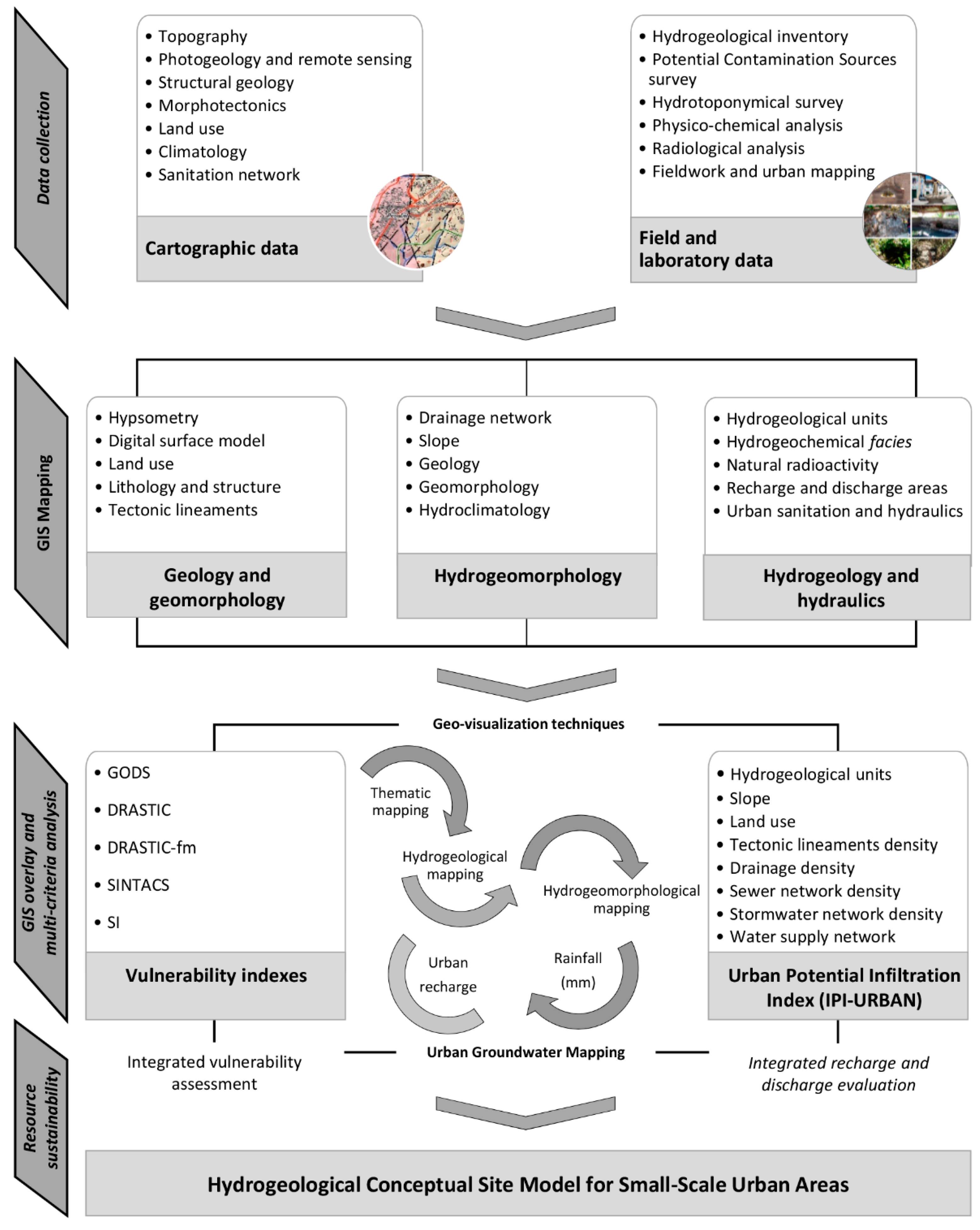

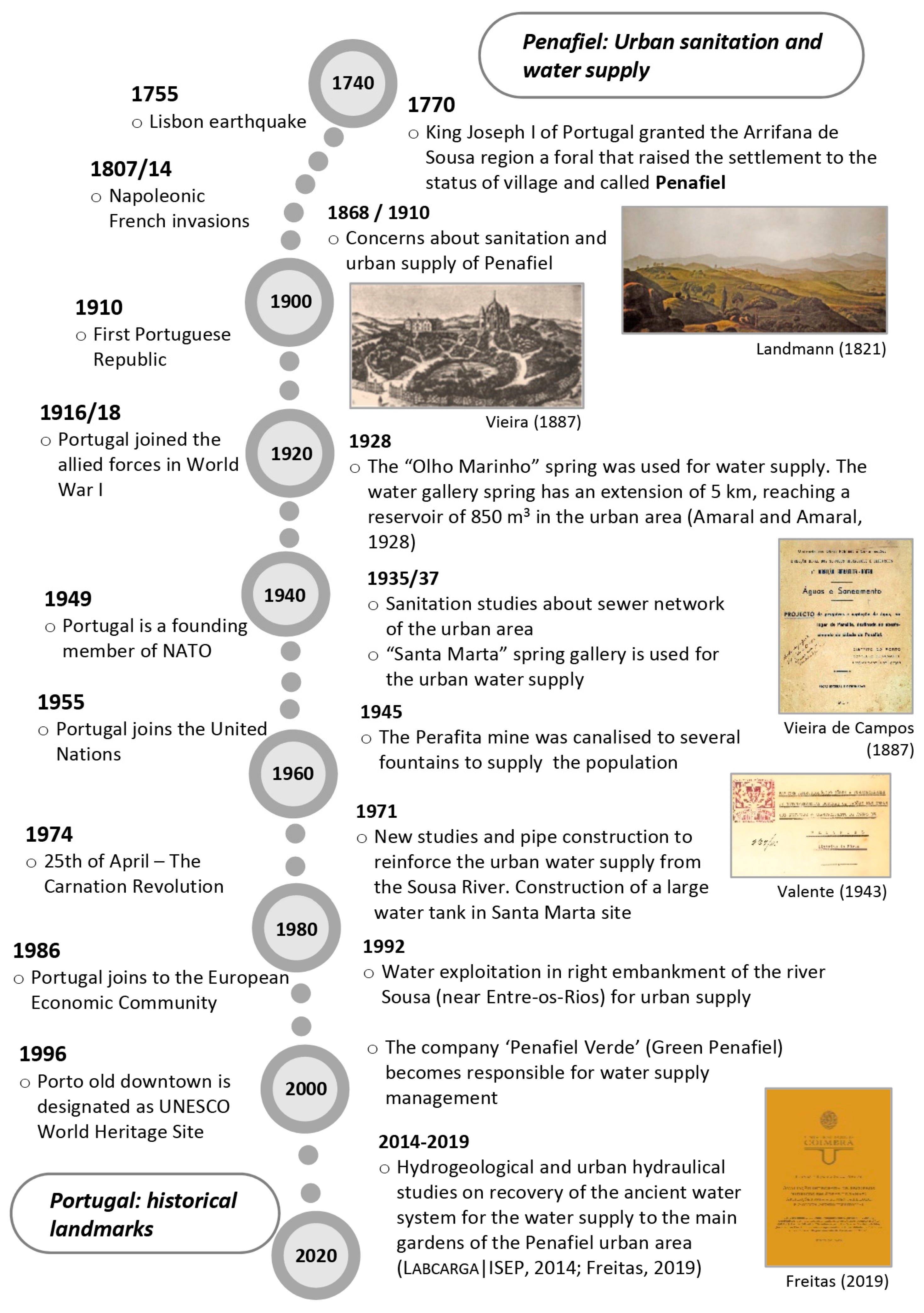


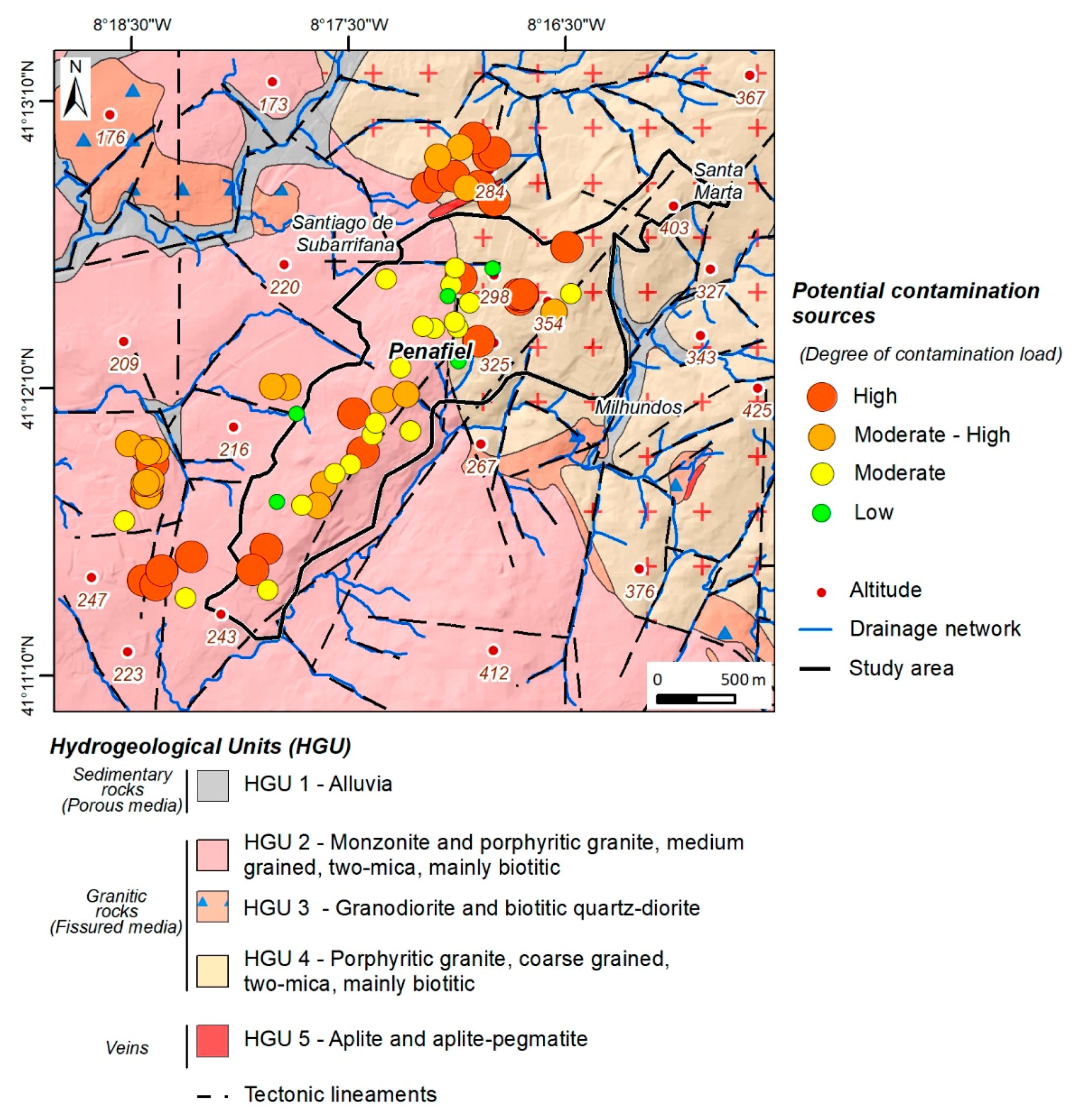
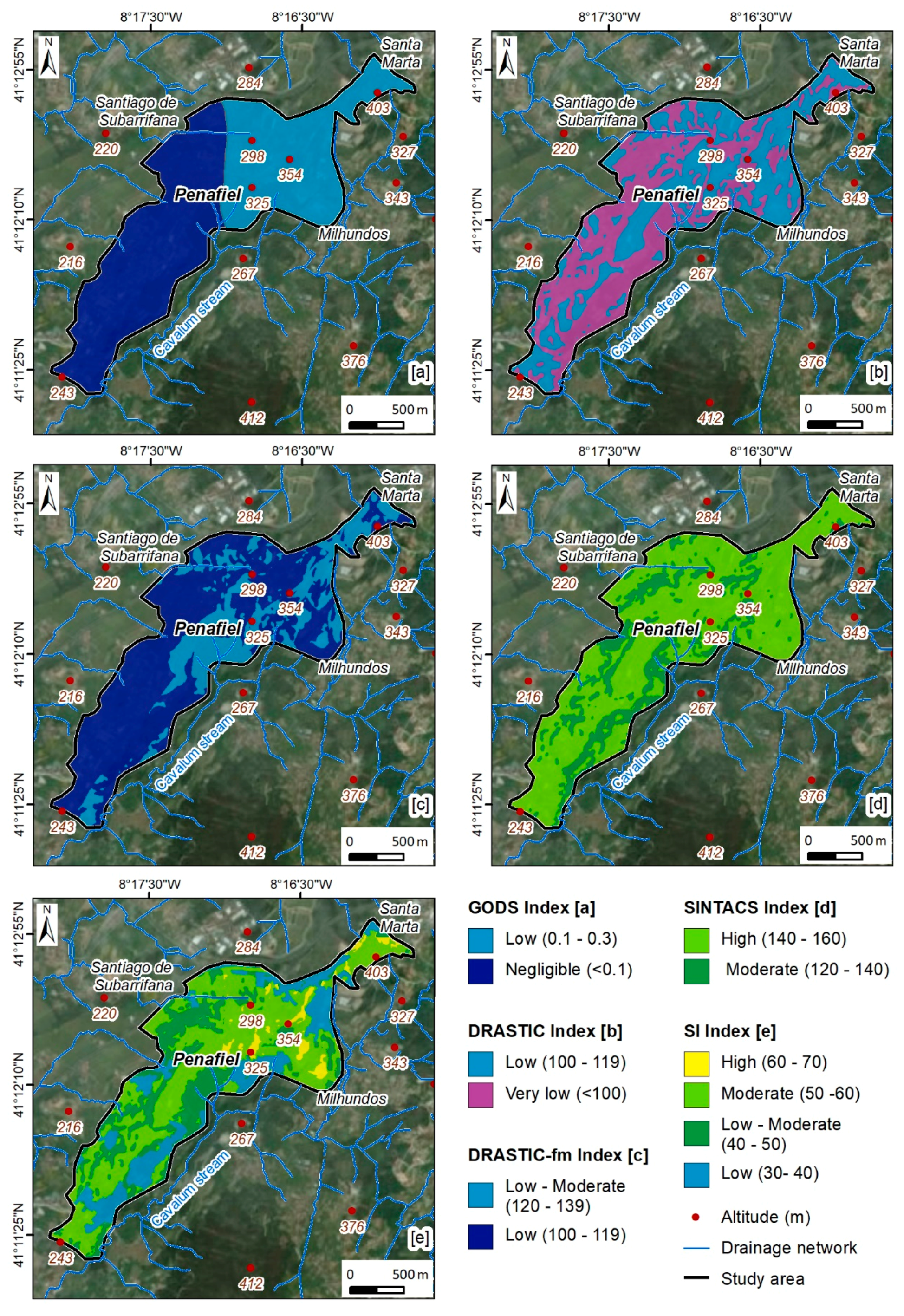

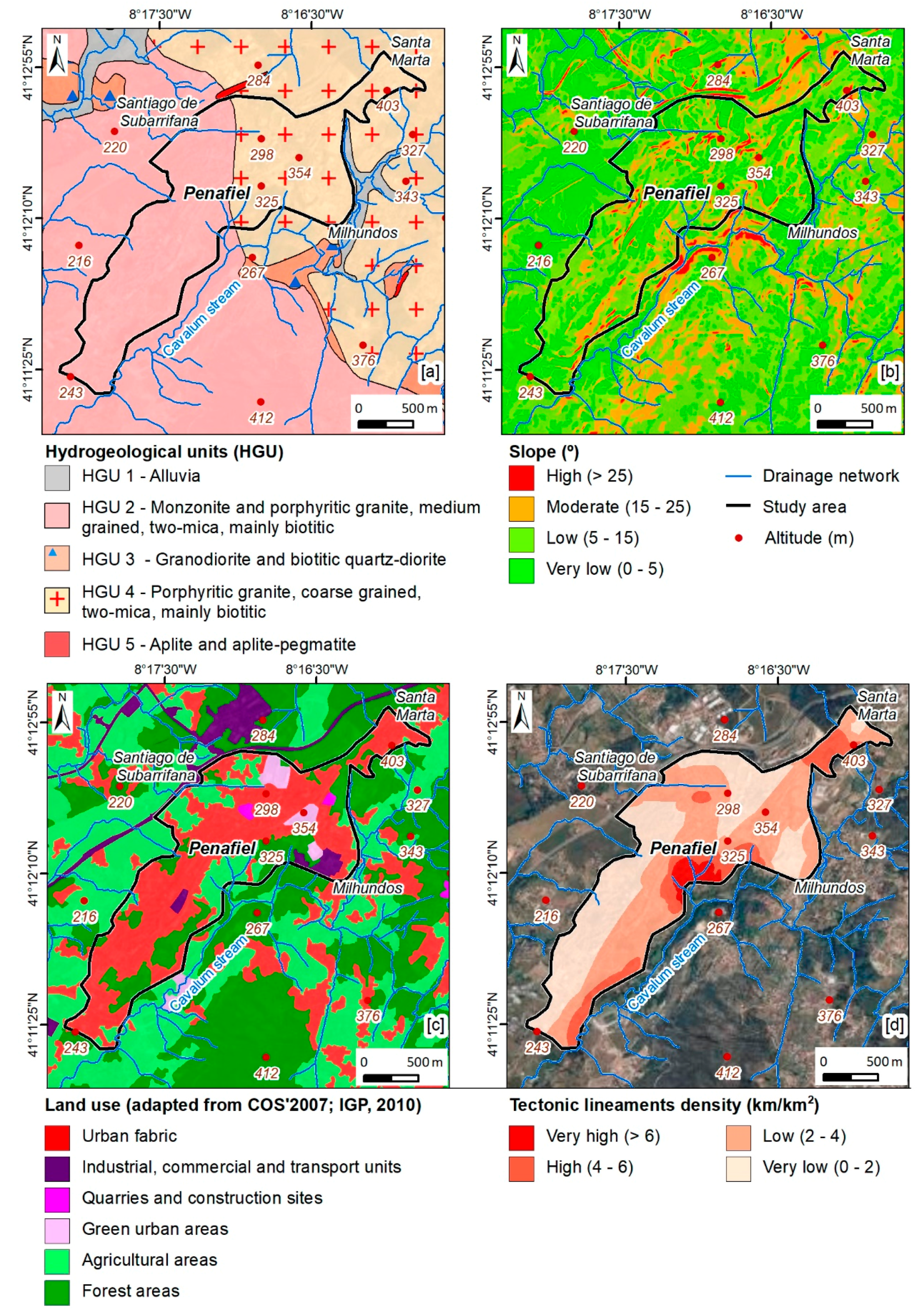

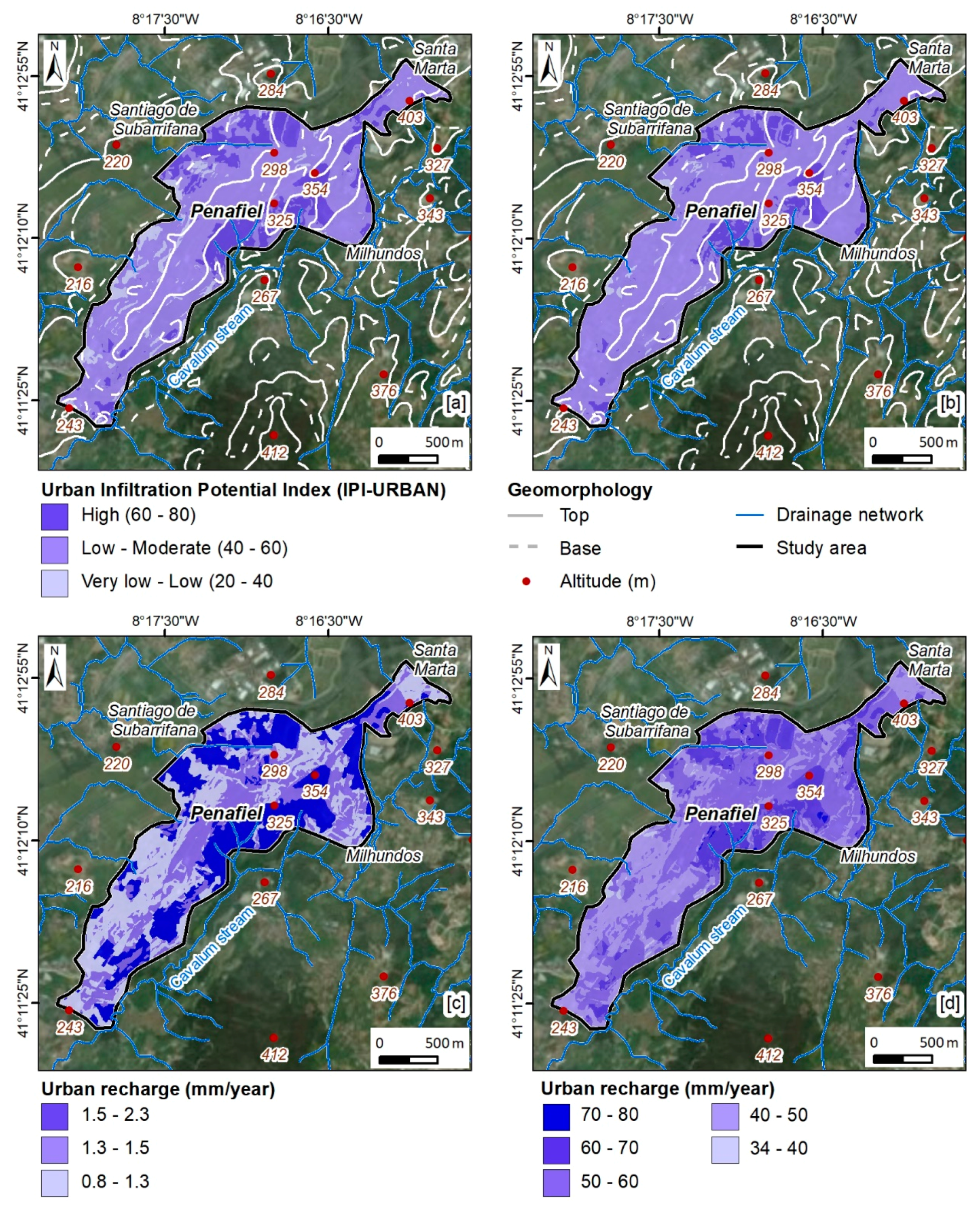
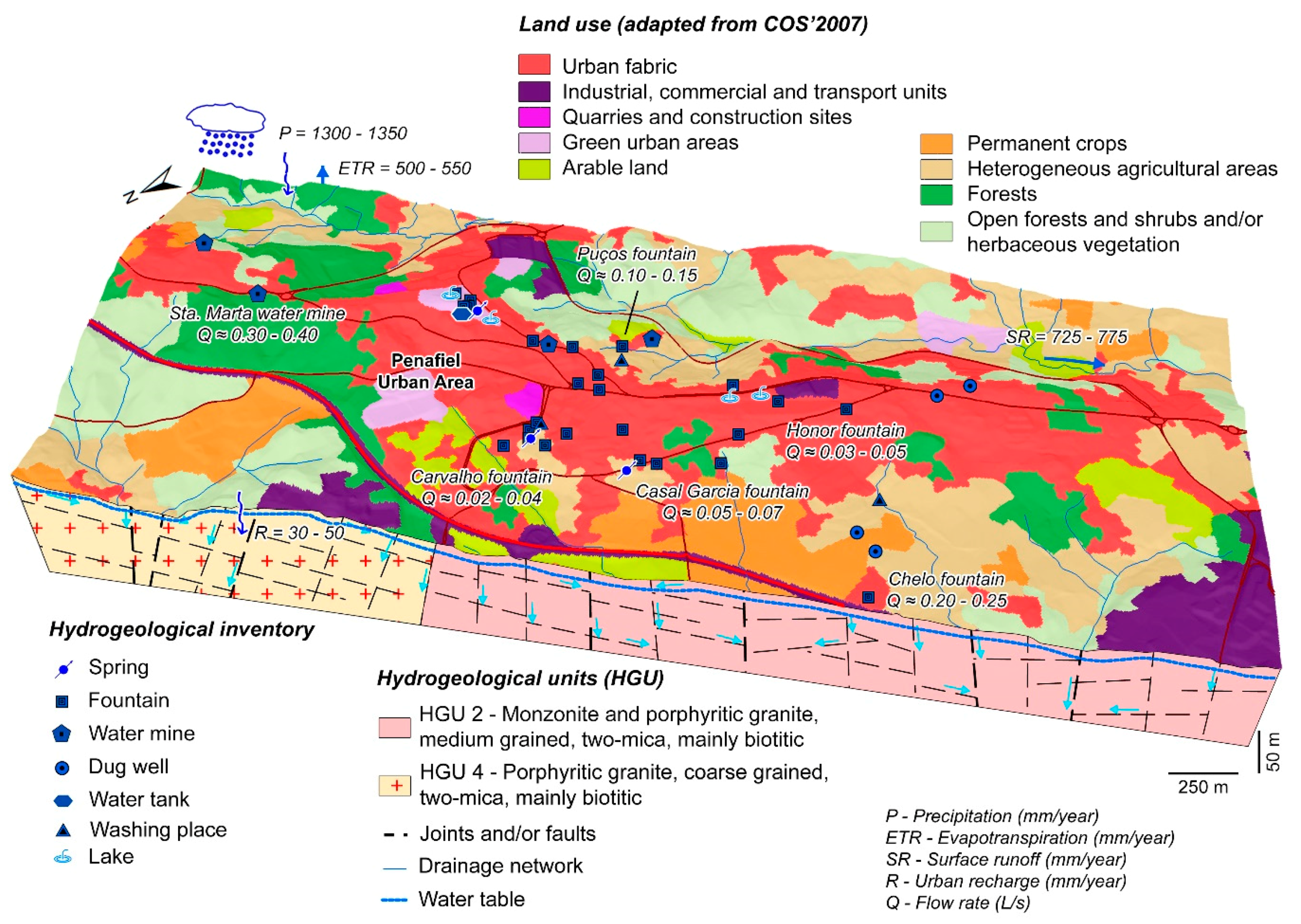
| Urban Infiltration Potential Index (IPI-URBAN) | Summer Scenario | Winter Scenario | |
|---|---|---|---|
| weight (%) | weight (%) | ||
| Hydrogeological Units (HGU) | Geology, hydrogeology and morphotectonics | 25.8 | 25.1 |
| Tectonic lineaments density | 14.6 | 16.2 | |
| Land use | Hydrology and hydrogeomorphology | 22.1 | 15.8 |
| Slope | 15.3 | 13.2 | |
| Drainage density | 5.7 | 4.7 | |
| Sewer network density | Urban hydraulics and sanitation | 6.3 | 5.9 |
| Stormwater network density | n.a | 5.9 | |
| Water supply network density | 10.2 | 13.2 | |
| n.a.—not applicable | |||
| GODS Index | Area (km2) | % |
| Low (0.1–0.3) | 1.3 | 42.5 |
| Negligible (<0.1) | 1.8 | 57.5 |
| DRASTIC Index | Area (km2) | % |
| Low (100–119) | 1.4 | 47.3 |
| Very low (<100) | 1.6 | 52.7 |
| DRASTIC-fm Index | Area (km2) | % |
| Low–Moderate (120–140) | 0.9 | 30.9 |
| Low (100–120) | 2.1 | 69.1 |
| SINTACS Index | Area (km2) | % |
| High (140–160) | 2.3 | 77.9 |
| Moderate (120–140) | 0.7 | 22.1 |
| SI Index | Area (km2) | % |
| High (60–70) | 0.1 | 4.1 |
| Moderate (50–60) | 1.5 | 50.8 |
| Low–Moderate (40–50) | 0.7 | 24.7 |
| Low (30–40) | 0.6 | 20.5 |
| Urban Infiltration Potential Index (IPI-URBAN) | Summer | Winter | |||
| Area (km2) | % | Area (km2) | % | ||
| High (60–80) | 0.7 | 21.6 | 0.5 | 14.9 | |
| Low–Moderate (40–60) | 2.2 | 71.0 | 2.5 | 82.9 | |
| Very low–Low (20–40) | 0.2 | 7.4 | 0.1 | 2.2 | |
| Urban Recharge (mm/year) | |||||
| Summer | Area (km2) | % | Winter | Area (km2) | % |
| <1.3 | 1.1 | 36.1 | <40 | 0.04 | 1.4 |
| 1.3–1.5 | 0.9 | 28.3 | 40–50 | 0.93 | 30.8 |
| 1.5–2.3 | 1.1 | 35.6 | 50–60 | 1.41 | 46.6 |
| - | - | - | 60–70 | 0.63 | 20.8 |
| - | - | - | 70–80.6 | 0.01 | 0.5 |
© 2020 by the authors. Licensee MDPI, Basel, Switzerland. This article is an open access article distributed under the terms and conditions of the Creative Commons Attribution (CC BY) license (http://creativecommons.org/licenses/by/4.0/).
Share and Cite
Freitas, L.; Chaminé, H.I.; Afonso, M.J.; Meerkhan, H.; Abreu, T.; Trigo, J.F.; Pereira, A.J.S.C. Integrative Groundwater Studies in a Small-Scale Urban Area: Case Study from the Municipality of Penafiel (NW Portugal). Geosciences 2020, 10, 54. https://doi.org/10.3390/geosciences10020054
Freitas L, Chaminé HI, Afonso MJ, Meerkhan H, Abreu T, Trigo JF, Pereira AJSC. Integrative Groundwater Studies in a Small-Scale Urban Area: Case Study from the Municipality of Penafiel (NW Portugal). Geosciences. 2020; 10(2):54. https://doi.org/10.3390/geosciences10020054
Chicago/Turabian StyleFreitas, Liliana, Helder I. Chaminé, Maria José Afonso, Helen Meerkhan, Tiago Abreu, José Filinto Trigo, and Alcides J. S. C. Pereira. 2020. "Integrative Groundwater Studies in a Small-Scale Urban Area: Case Study from the Municipality of Penafiel (NW Portugal)" Geosciences 10, no. 2: 54. https://doi.org/10.3390/geosciences10020054
APA StyleFreitas, L., Chaminé, H. I., Afonso, M. J., Meerkhan, H., Abreu, T., Trigo, J. F., & Pereira, A. J. S. C. (2020). Integrative Groundwater Studies in a Small-Scale Urban Area: Case Study from the Municipality of Penafiel (NW Portugal). Geosciences, 10(2), 54. https://doi.org/10.3390/geosciences10020054







